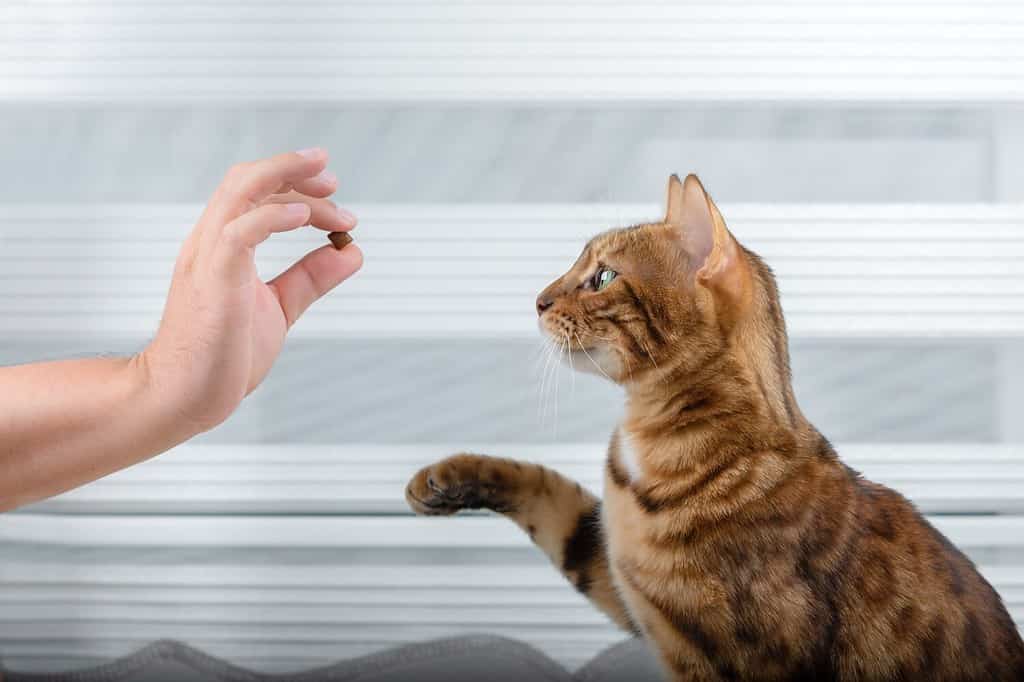Some are more reserved while others enjoy being the center of attention. Cats have innate personalities but there is a lot you can do to shape them early on. Discover how to socialize a cat with other humans!
How to Socialize a Cat with Other Humans: 10 Critical Steps You Should Take
1. Get Your Cat Comfy

Make sure your cat is comfortable in its environment before introducing it to other humans.
©Jasmine_K/Shutterstock.com
When you start socializing your cat with other humans, your cat should already be in a calm, comfortable environment. If your cat doesn’t feel safe, it’s immediately going to hide when somebody new enters the room. Make sure your cat has a little hideout where it can retreat if it’s startled by the presence of someone new.
For instance, if your cat normally runs under the bed in your bedroom, you might let your cat roam in the living room but provide it with a tunnel or other hideout to retreat to and feel safe in an enclosed environment. A cat tree may help as well as it allows cats to observe from a higher perspective, letting them analyze movement in the room and get a sense of the people you bring home. This way, they can decide on their own terms if they wish to get closer and explore a new person further.
2. Set a Regular Food and Treat Schedule

A consistent food schedule helps your cat associate humans with food.
©Svetlana Rey/Shutterstock.com
Another way that you can help to socialize a cat with other humans is to keep a steady feeding schedule. They can have a specific time when they get breakfast and a specific time when they get dinner. They might have an afternoon snack as well. It doesn’t matter what the schedule looks like just that you create one so that your cat associates food with human interaction.
If you live with your family members or roommates, you might have them feed your cat once in a while. Cats have impressively accurate internal clocks and are always happy to eat and savor their food. By allowing another member of your family or a friend to feed them, they’re naturally relating that person with food, which is a positive association.
3. Connect Via Play

Schedule daily play sessions with your cat so they associate humans with fun and play.
©scaliger/iStock via Getty Images
You’re going to have to put in some groundwork with your cat to make sure that it associates humans with positive interactions. Make play a part of your daily routine. Your cat has bursts of energy and with just two or three 10-minute play sessions per day, you can teach your cat that humans are fun and interesting.
As you introduce new people to your cat, have them mimic the same types of behaviors you exhibit when you’re playing with your cat. Whether that means using little mouse toys or a feather teaser wand, when a new person shows evidence of the same behaviors that you have been exhibiting, your cat begins to associate that new person with fun and play as well.
4. Try Exchanging Scents

Cats use their sense of smell to understand their environment.
©Myskina6/iStock via Getty Images
Cats communicate via scents, which is why they rub up against you when you get home. They’re claiming you as theirs as you’ve entered their territory. They want to get any other scents off of you! People you bring in from outside the home smell differently to your cat. They can pick up on this immediately and it lets them know that they are from a different territory.
By exchanging their scents, you can let your cat know that this person wants to be a part of its territory. You can do this by taking an item that your cat frequents like a blanket or a pet bed and rubbing it on the person you bring home. This way, there’s a mix of their scent along with your cat’s scent in the place your cat frequents. Your cat will explore and recognize the scent of the person, which may lead them to claim that person as their own every time they walk into your home.
5. Invite People Over

Inviting people over helps your cat get acquainted with other humans.
©Olesya Kuznetsova/Shutterstock.com
You won’t be at all successful at socializing your cat with humans if you live alone and don’t make an effort to invite people over. While some people are highly introverted and love cats as company, in order to have a socialized cat, you need to have people over. You might suggest having a study session over at your home or having a weekly dinner with friends or family. Socializing with different people ensures that your cat also behaves well when you have to introduce it to someone new like a vet, vet technician, or even a pet sitter.
6. Introduce New People Gently

Cats are specific about touch. Start gently with introductions to other humans.
©Liam Bell/iStock via Getty Images
When we say invite people over, we don’t need to have a party. To socialize a cat, you have to be gentle with the introductions. You don’t want to startle your cat because that’ll create a negative association with new people. You must respect your cat’s boundaries. Your cat will be very clear about what it is and is not okay with. When you introduce someone new, your cat may just retreat to its preferred location and watch the new person from afar.
If your cat approaches, teach the new person how to approach your cat. Have them hold out their hand in a relaxed fist and crouch down in front of your cat. This allows your cat to sniff the new person and decide if they want to get closer or stay a little bit further away. New people with other pets at home may repel your cat but eventually, with enough greetings, your cat may accept the new person and give them a little headbutt. That’s a wonderful sign!
7. Be Consistent With Interactions

Cats need consistency. Create schedules for a predictable environment.
©Rawf8/iStock via Getty Images
A yearly dinner with friends simply won’t cut it for socializing your cat. Be sure you’re consistent with your introductions and with the people who stop by or who live with you and interact with your cat. Cats are creatures of habit, and they expect predictability. If the home is too chaotic and there are people coming in and out without acknowledging your cat, it can create a stressed-out kitty.
Instead, be consistent with the interactions, using feeding schedules or play schedules to create a predictable environment for your cat. For example, if grandma always comes over on Fridays, your cat is going to look forward to those visits and operate with a sense of safety, knowing what to expect.
8. Employ Patience

Be patient with your cat during socialization. It’s worth it.
©Evrymmnt/iStock via Getty Images
Cats are constantly teaching you how to be patient. While some cats have the personality of a dog and they’re eager to please, others are always minding their own business. They do things at their leisure, and they don’t listen to your requests. Socializing a cat with other humans is yet another lesson in patience. If you push too hard too quickly, you’re going to turn your cat off from interacting with other humans. The best you can do is move at your cat’s pace.
9. Try Noise Exposure

Without noise exposure, your cat may startle too easily, making it difficult to introduce other humans.
©Ozge Emir/iStock via Getty Images
When new people are introduced to the home, they speak differently, laugh at different volumes, and make noise in a different way. A man walking in with boots is going to sound different than a woman walking in with heels. To help your cat become acquainted with different sounds, try noise exposure.
For example, when the garbage truck comes by your home on a certain day of the week, open the window so that your cat can hear the different noises. Turn on the TV and let that play so that your cat can get accustomed to the different sounds humans make. You might also try vacuuming in a room they’re in so that your cat isn’t alarmed by loud noises. Instead, your cat can get accustomed to and desensitized to the sound of human activity.
10. Reinforce Positive Interactions

Reward your cat after positive interactions!
©iStock.com/Nils Jacobi
Some cats are going to take to other humans more easily. Cats are born with specific personalities so a cat that is a bit more reserved and shy may take longer to socialize with other humans. There is no set timeline, however, with consistency and patience, you can help your cat feel more comfortable around people. Whenever your cat has a positive interaction with someone new, offer them a reward. Grab a treat and immediately hand it over to your cat so that it knows that these positive interactions with humans mean a reward is coming!
The photo featured at the top of this post is © SeventyFour/iStock via Getty Images
Thank you for reading! Have some feedback for us? Contact the AZ Animals editorial team.






